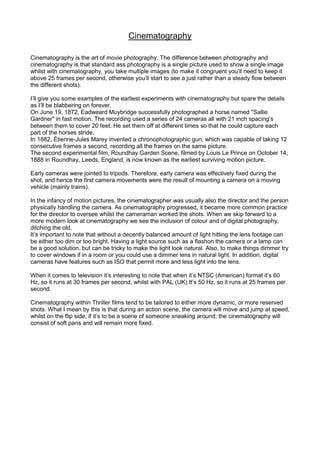
Art of Movie Photography
- 1. Cinematography Cinematography is the art of movie photography. The difference between photography and cinematography is that standard ass photography is a single picture used to show a single image whilst with cinematography, you take multiple images (to make it congruent you’ll need to keep it above 25 frames per second, otherwise you’ll start to see a just rather than a steady flow between the different shots). I’ll give you some examples of the earliest experiments with cinematography but spare the details as I’ll be blabbering on forever. On June 19, 1872, Eadweard Muybridge successfully photographed a horse named "Sallie Gardner" in fast motion. The recording used a series of 24 cameras all with 21 inch spacing’s between them to cover 20 feet. He set them off at different times so that he could capture each part of the horses stride. In 1882, Étienne-Jules Marey invented a chronophotographic gun, which was capable of taking 12 consecutive frames a second, recording all the frames on the same picture. The second experimental film, Roundhay Garden Scene, filmed by Louis Le Prince on October 14, 1888 in Roundhay, Leeds, England, is now known as the earliest surviving motion picture. Early cameras were jointed to tripods. Therefore, early camera was effectively fixed during the shot, and hence the first camera movements were the result of mounting a camera on a moving vehicle (mainly trains). In the infancy of motion pictures, the cinematographer was usually also the director and the person physically handling the camera. As cinematography progressed, it became more common practice for the director to oversee whilst the cameraman worked the shots. When we skip forward to a more modern look at cinematography we see the inclusion of colour and of digital photography, ditching the old. It’s important to note that without a decently balanced amount of light hitting the lens footage can be either too dim or too bright. Having a light source such as a flashon the camera or a lamp can be a good solution, but can be tricky to make the light look natural. Also, to make things dimmer try to cover windows if in a room or you could use a dimmer lens in natural light. In addition, digital cameras have features such as ISO that permit more and less light into the lens. When it comes to television it’s interesting to note that when it’s NTSC (American) format it’s 60 Hz, so it runs at 30 frames per second, whilst with PAL (UK) It’s 50 Hz, so it runs at 25 frames per second. Cinematography within Thriller films tend to be tailored to either more dynamic, or more reserved shots. What I mean by this is that during an action scene, the camera will move and jump at speed, whilst on the flip side, if it’s to be a scene of someone sneaking around; the cinematography will consist of soft pans and will remain more fixed.